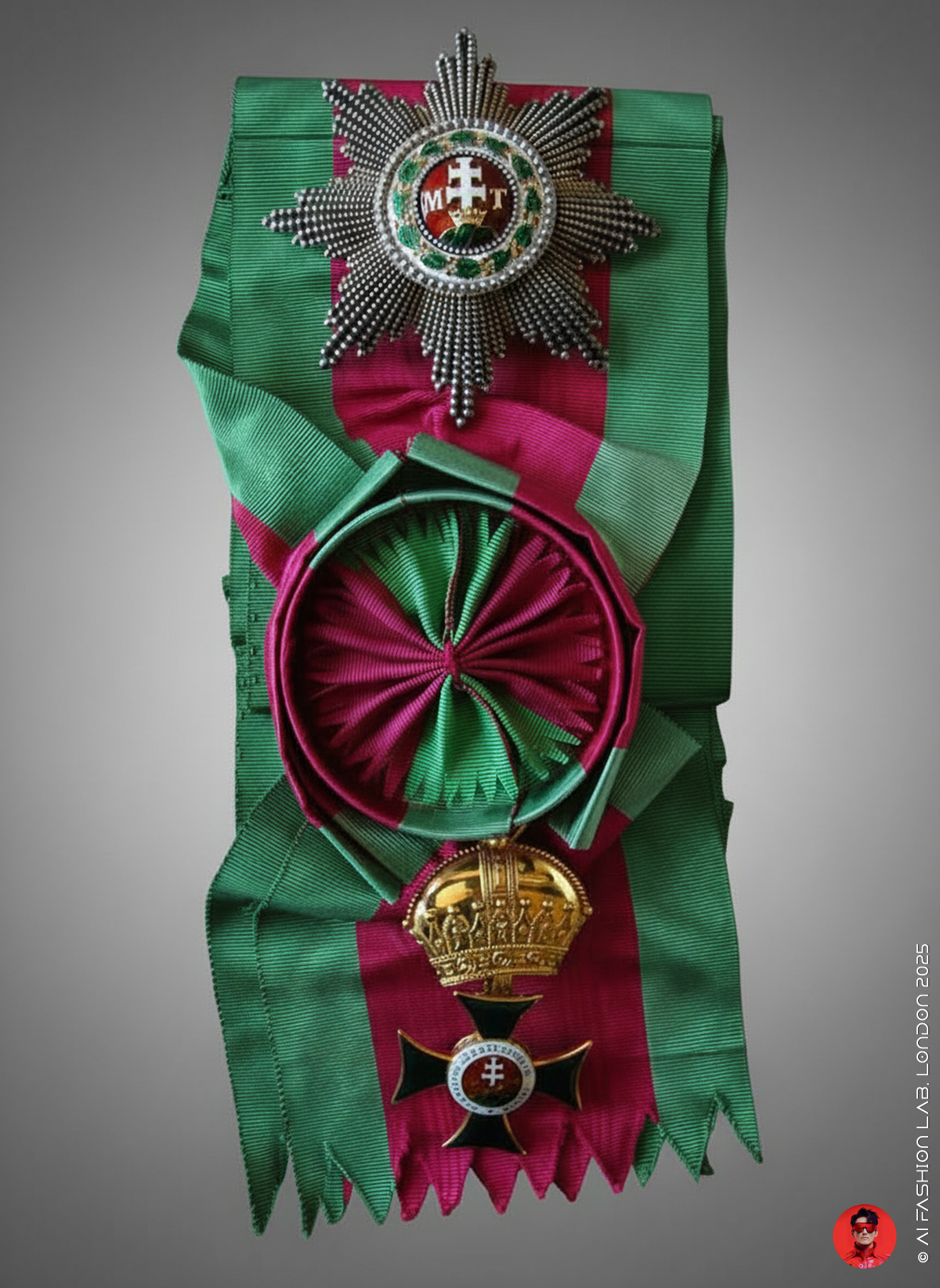รัชกาลที่ ๕ และเครื่องราชอิสริยาภรณ์เซนต์สตีเฟนแห่งฮังการี (Order of St Stephen)
รัชกาลที่ ๕ และเครื่องราชอิสริยาภรณ์เซนต์สตีเฟนแห่งฮังการี (Order of St Stephen)
คอลเลกชันภาพที่ได้รับการบูรณะและสร้างสรรค์ขึ้นใหม่ด้วยเทคโนโลยี AI ชุดนี้ คือพระบรมฉายาลักษณ์ของรัชกาลที่ ๕ ซึ่งสันนิษฐานว่าทรงฉายเมื่อพระบาทสมเด็จพระจุลจอมเกล้าเจ้าอยู่หัวมีพระชนมพรรษาเพียง ๑๕ พรรษา เป็นภาพถ่ายที่สะท้อนพลวัตทางการเมือง การทูต และการประกาศพระองค์อย่างสำคัญในช่วงต้นรัชกาล ภาพถ่ายนี้น่าจะจัดฉายหลังพระราชพิธีบรมราชาภิเษกครั้งแรกในปี พ.ศ. ๒๔๑๑ (ค.ศ. ๑๘๖๘) อันเป็นปีเดียวกับที่พระองค์ทรงได้รับเครื่องราชอิสริยาภรณ์เซนต์สตีเฟนแห่งฮังการี (Order of St Stephen) จากสมเด็จพระจักรพรรดิฟรานซ์ โยเซฟ แห่งจักรวรรดิออสเตรีย–ฮังการี
การได้รับพระราชทานเครื่องราชอิสริยาภรณ์จากราชสำนักยุโรปที่ทรงอำนาจเช่นนี้ในปีแห่งการเสด็จขึ้นครองราชฯ มีความหมายเชิงการเมืองอย่างยิ่ง เนื่องจากในช่วงเวลานั้นพระองค์ยังทรงอยู่ภายใต้การสำเร็จราชการของสมเด็จเจ้าพระยาบรมมหาศรีสุริยวงศ์ (ช่วง บุนนาค) และยังมิได้ทรงบริหารราชกิจด้วยพระองค์เอง การได้รับพระราชทานเครื่องราชอิสริยาภรณ์โดยตรงสะท้อนว่าราชสำนักออสเตรีย–ฮังการียอมรับพระองค์ในฐานะประมุขของประเทศอย่างสมบูรณ์ มิใช่เพียงในเชิงพิธีการ แต่ในฐานะคู่เจรจาบนเวทีระหว่างประเทศ นับเป็นการยืนยันสถานะของพระองค์อย่างชัดเจนในช่วงเวลาที่พระราชอำนาจภายในยังถูกจำกัดอย่างเข้มงวดโดยระบบสำเร็จราชการ
การปรากฏของเครื่องราชอิสริยาภรณ์เซนต์สตีเฟนในพระบรมฉายาลักษณ์นี้สะท้อนให้เห็นว่าการเลือกประดับเครื่องราชต่างประเทศไม่ใช่เพียงการเสริมพระเกียรติยศของฉลองพระองค์ แต่เป็นการสื่อสารทางการเมืองที่มีเจตนาชัดเจน ภายในราชสำนักสยาม เครื่องราชฯ นี้ทำหน้าที่เป็นหลักฐานของการยอมรับจากนานาชาติ ซึ่งช่วยยกระดับพระราชอำนาจของพระมหากษัตริย์ผู้ทรงพระเยาว์เหนือข้อจำกัดของคณะผู้สำเร็จราชการ ในสายตาของขุนนางและเจ้าหน้าที่ราชสำนัก ภาพฉายพร้อมเครื่องราชอิสริยาภรณ์อันสูงศักดิ์จากยุโรปเป็นการตอกย้ำว่าพระองค์มิได้ทรงเป็นเพียงกษัตริย์โดยนิตินัยเท่านั้น หากยังเป็นผู้ได้รับการยอมรับในระดับนานาชาติอย่างแท้จริง แม้ว่าพระราชอำนาจเชิงบริหารจะยังมิได้อยู่ในพระหัตถ์ของพระองค์ก็ตาม
นอกจากนี้ พระบรมฉายาลักษณ์ยังสะท้อนบทบาทของภาพถ่ายในฐานะเครื่องมือการทูตซึ่งทวีความสำคัญขึ้นในศตวรรษที่ ๑๙ ราชสำนักยุโรปนิยมให้พระมหากษัตริย์ผู้ได้รับเครื่องราชอิสริยาภรณ์ส่ง “ภาพฉายพร้อมเครื่องราชฯ” กลับไปยังราชสำนักผู้พระราชทาน เพื่อแสดงการตอบรับอย่างเป็นทางการ พระบรมฉายาลักษณ์นี้จึงมีความเป็นไปได้สูงว่าเป็นภาพซึ่งจัดทำขึ้นเพื่อทูลเกล้าฯ ถวายแด่พระจักรพรรดิฟรานซ์ โยเซฟ หรือเพื่อให้ราชสำนักออสเตรีย–ฮังการีจัดเก็บไว้ในหมู่เอกสารสำคัญของตน การส่งรูปภาพเช่นนี้เป็นการประกาศตัวตนของพระมหากษัตริย์สยามในเวทีระหว่างประเทศ และเป็นการสื่อสารว่าพระองค์ทรงเป็นผู้รับผิดชอบความสัมพันธ์ทางการทูต แม้ในทางปฏิบัติพระองค์ยังทรงถูกจำกัดบทบาทโดยผู้สำเร็จราชการก็ตาม
พระบรมฉายาลักษณ์นี้จึงเป็นหลักฐานสำคัญของพระราชอำนาจเชิงสัญลักษณ์ (symbolic kingship) ซึ่งเป็นรูปแบบพระราชอำนาจที่พระบาทสมเด็จพระจุลจอมเกล้าเจ้าอยู่หัวสามารถทรงใช้อย่างเต็มที่ แม้ว่าพระราชอำนาจเชิงบริหารจะยังมิได้อยู่ภายใต้พระบรมราชวินิจฉัยโดยสิ้นเชิง การจัดวางเครื่องราชอิสริยาภรณ์ของสยาม เช่น นพรัตนราชวราภรณ์และเครื่องราชอิสริยาภรณ์ช้างเผือก ควบคู่กับเครื่องราชฯ ต่างประเทศ จึงเป็นการประกาศว่าพระองค์ทรงเป็นศูนย์กลางของทั้งคติจักรวาลแบบสยามและเครือข่ายการทูตยุโรปในขณะเดียวกัน การใช้ภาพถ่ายซึ่งเป็นเทคโนโลยีใหม่ที่สยามรับจากโลกตะวันตกยังสะท้อนพระราชวิสัยทัศน์กว้างไกล และความเข้าใจว่ารูปถ่ายสามารถเป็นพื้นที่การเมืองรูปแบบใหม่ที่ไม่ถูกจำกัดด้วยราชประเพณีหรือโครงสร้างการปกครองในระบบการสำเร็จราชการ
ดังนั้น พระบรมฉายาลักษณ์นี้จึงมิใช่เพียงภาพทรงเครื่องตามขนบ หากเป็นเอกสารทางการทูตและการเมืองในช่วงหัวเลี้ยวหัวต่อของสยามในศตวรรษที่ ๑๙ ภาพนี้เผยให้เห็นว่าพระมหากษัตริย์สยามได้ทรงก้าวสู่เวทีระหว่างประเทศแล้ว แม้พระองค์ยังมิได้ทรงมีพระราชอำนาจเต็มรูปแบบก็ตาม พระบรมฉายาลักษณ์นี้จึงเป็นภาพแทนอนาคตของสยาม อนาคตแห่งการปฏิรูป การเจรจาทางการทูต และการกำหนดบทบาทของรัฐสยามในระบบระหว่างประเทศสมัยใหม่
___________________________
King Chulalongkorn and Order of St Stephen
This AI-restored and newly interpreted photographic collection presents a portrait of King Chulalongkorn (Rama V), believed to have been taken when he was approximately fifteen years old. The image captures a critical moment in the early reign of a young monarch whose political authority was still constrained by the Regency under Somdet Chao Phraya Borom Maha Sri Suriwongse. The portrait is thought to date from shortly after the First Coronation in 1868 (2411 BE), the same year in which the King received the prestigious Order of St Stephen of Hungary from Emperor Franz Josef of the Austro-Hungarian Empire. The bestowal of such a high European order in the very year of the coronation carried significant political meaning: it signalled that the Habsburg court recognised Chulalongkorn personally as the sovereign ruler of Siam, despite his minority and the fact that domestic political authority at the time rested in the hands of the Regent. This external recognition affirmed the legitimacy of the young king not merely ceremonially but substantively, acknowledging him as a participant in international diplomacy at a time when his internal powers were tightly circumscribed.
The appearance of the Order of St Stephen in this portrait therefore reveals that the selection of foreign insignia was not an aesthetic flourish but a deliberate political statement. Within the Siamese court, the presence of such an eminent foreign decoration operated as evidence of international endorsement, elevating the symbolic authority of the young king above the structural limitations imposed by the Regency. In the eyes of senior nobles and court officials, the portrait—showing Chulalongkorn adorned with one of Europe’s most prestigious chivalric orders—affirmed that he was not merely a king by lineage or ritual, but one who had already been acknowledged by a major European power. This conveyed a subtle yet powerful message: even without full administrative authority, the monarch possessed a form of international legitimacy that no Regent could substitute or replicate.
The photograph further illustrates the emerging diplomatic role of photography in the nineteenth century. It was common practice in European courts for a monarch who received a foreign order to send a formal portrait wearing the insignia back to the gifting sovereign as a gesture of acceptance and reciprocity. It is therefore highly plausible that this portrait was produced for presentation to Emperor Franz Josef or for archival preservation within the Austro-Hungarian court. Such an exchange would have functioned as the young king’s first act of diplomatic self-representation, symbolically placing him—rather than the Regent—at the centre of Siam’s foreign relations. The image thus acted as a medium through which Chulalongkorn could assert a political presence internationally, even though his domestic authority remained constrained.
In this sense, the portrait must be understood as a key document of symbolic kingship in early Chulalongkorn-era Siam. It demonstrates the form of royal power that the King was able to exercise fully during the Regency: the power to shape meaning through dress, insignia, and the strategic use of photography. By juxtaposing Siamese orders such as the Order of the Nine Gems and the Order of the White Elephant with an eminent European decoration, the portrait presents the King as both the centre of Siam’s cosmological hierarchy and an emerging actor within the diplomatic networks of Europe. The choice to deploy photography—a new Western technology introduced to Siam only a few decades earlier—further reflects Chulalongkorn’s modernising sensibility and his understanding that images could constitute a new arena of political representation, independent of traditional court ritual or the constraints of the Regency system.
Thus, this portrait is far more than a ceremonial depiction. It is a diplomatic and political artefact created at a moment of profound transition in Siam’s nineteenth-century history. The image communicates simultaneously to the Siamese elite and to the outside world that the young monarch had already stepped onto the international stage, even before he attained full sovereign authority. It becomes, therefore, a visual emblem of the future trajectory of Siam under King Chulalongkorn: a future defined by reform, diplomatic negotiation, and the articulation of a modern Siamese state within the broader international order.
#aifashionlab #AI #aiartist #aiart #aifashion #aifashiondesign #aifashionstyling #aifashiondesigner #fashion #fashionhistory #historyoffashion #fashionstyling #fashionphotography #digitalfashion #digitalfashiondesign #digitalcostumedesign #digitaldesign #digitalaiart #ThaiFashionHistory #ThaiFashionAI #thailand #UNESCO



